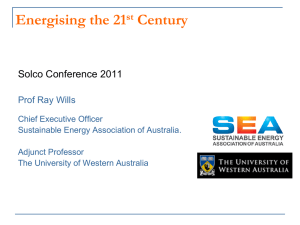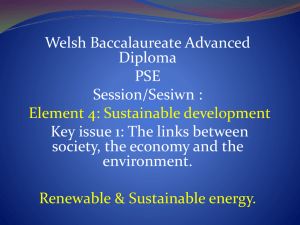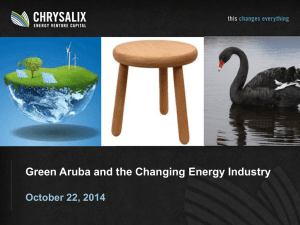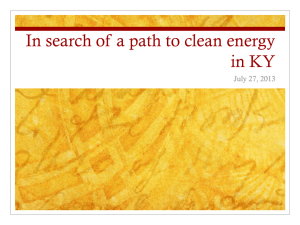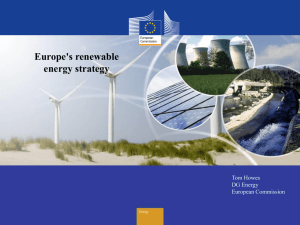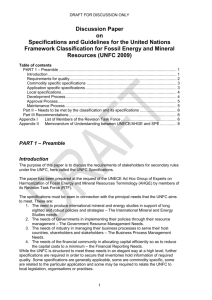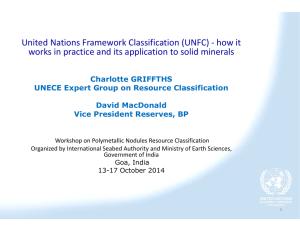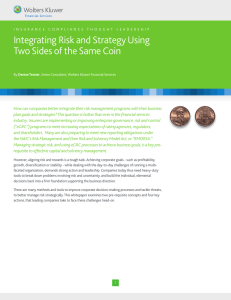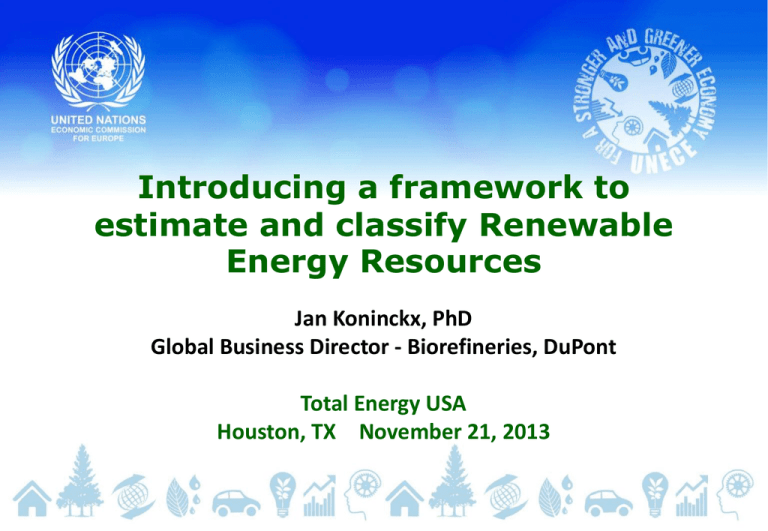
Introducing a framework to
estimate and classify Renewable
Energy Resources
Jan Koninckx, PhD
Global Business Director - Biorefineries, DuPont
Total Energy USA
Houston, TX November 21, 2013
Presentation objectives
• Introduce an ongoing initiative to develop a framework for
estimating and classifying Renewable Energy resources
• Explain how the definitions and principles of the United
Nations Framework Classification for Fossil Energy and
Mineral Reserves and Resources 2009 (UNFC-2009) can
also be applied to Renewables
• Solicit feedback and comments from Renewable Energy
stakeholders
1
Background
• The UN Economic Commission for Europe’s called upon the Expert Group on
Resource Classification (EGRC) to “develop ideas on how the UNFC could
apply to and integrate renewable energy by December 2013”
• Separately, an industry-led working group took the initiative to develop a
transparent and consistent estimation and classification methodology for
renewable energy resources
• The working group reported their findings at the fourth session of the EGRC
held in Geneva, April 2013
• The EGRC established a Task Force on the Application of UNFC-2009 to
Renewable Energy Resources
2
What is the UNFC?
• United Nations Framework Classification for Fossil
Energy and Mineral Reserves and Resources (UNFC)
• Global, generic, principles-based “umbrella” system
– Solid minerals and fluids
– Numerical coding system
– Facilitates global communications
• Compatible, integral, and collaborative (CRIRSCO Template for minerals
& PRMS for oil & gas)
• Other systems and primary fuels could align with UNFC in the future
3
E axis
categories
UNFC – How it works
4
UNFC – How it works
Category
Definition
E1
UNFC Class: 111
Extraction and sale has
been confirmed to be
economically viable.
Category
Definition
F1
Feasibility of extraction by
a defined development
project or mining operation
has been confirmed.
Category
Definition
G1
Quantities associated with
a known deposit that can
be estimated with a high
level of confidence.
5
Resources are estimated and classified
based on a “project”
The project generally
represents represent the level
at which a decision is made
whether or not to proceed
(i.e., spend more money)
6
Renewable energy projects are similar
to fossil energy or mineral projects
Some differences:
• The energy source does
not deplete
• Geological risks do not
apply to most Renewable
energy projects, but
similar uncertainties exist
(e.g. meteorological
variations, seasonal
variations etc)
7
Oil field vs. wind farm
(example)
Common project characteristics:
• A defined level of investment, with
an expected production profile
• Prerequisites such as gaining
access to the resource and
market, receiving authorisation,
and validation of the economic
case
• As the project develops, risk
declines and certainty of returns
improves
8
Click to edit
Master
title
style
A Renewable
Fuel
Example
Processing Losses
Sustained Carbon Source
Marketable Energy
Products
Liquid Fuel
Storage
Solid Fuel
Considerations
• Contracts with Farmers
• Farmer Operations History and
Productivity Trends
• Weather Uncertainty
Common project characteristics:
• A defined level of investment, with an expected
production profile
• Prerequisites such as gaining access to the resource and
market, receiving authorisation, and validation of the
economic case
• As the project develops, risk declines and certainty of
returns improves
November 2013 – Total Energy Houston
Copyright © 2013 DuPont. All rights reserved.
Task Force
The EGRC established a small Task Force in 2013, with
representatives from:
• Public sector (Australia)
• Private sector (Bioenergy)
• Private sector (Bioenergy; International Oil & Gas)
• Academia (Geothermal)
• Private sector (Bioenergy; Wind; International Oil & Gas)
• Private sector (Bioenergy; Solar; International Oil & Gas)
• Private sector (Finance & Reporting)
9
Task Force mandate
To develop a set of specifications for the application of
the UNFC-2009 to Renewables.
1
2
3
It is envisaged that this will consist of an overarching Renewable Specification
document, together with commodity-specific specifications and a conversion
document that will outline the conversion principles across energy metrics to
support a consistent comparison and reporting of various energy resources.
Near-term deliverables:
•Draft specifications for the application of the UNFC-2009 to Renewable Energy
•Workshop in March 2014 to consult with a broad group of global stakeholders
•Submission of the draft specifications to the EGRC for approval in April 2014
•Public consultation, following EGRC approval
10
The UNFC as umbrella framework for
all Energy & Mineral Resources
• A consistent methodology
across all Energy & Mineral
resources creates
transparency and
comparability
Task Force Scope
• The UNFC-2009 is and
remains a voluntary
system , intended as
framework, or a set of
common rules, that can be
adopted and used by
different stakeholders
11
Key stakeholder groups
Stakeholder
Driver / Interests
Governments
Better understand total resource base
Energy Security
Facilitate achievement of integrated energy strategy and policies
Global Organisations
Assess and contrast global energy systems and different energy sources
Renewable Energy Sector Participants
Enhanced overview of asset values
Provide a measure of comparability with traditional energy systems
Offer a basis to estimate the scale of each renewable resource
Provide reliable estimates based on best practices and common standards
Investment community
Better assess and contrast investment opportunities
Enhance portfolio valuation
12
Any feedback or questions?
13



